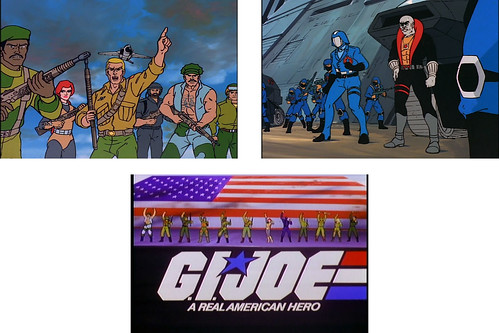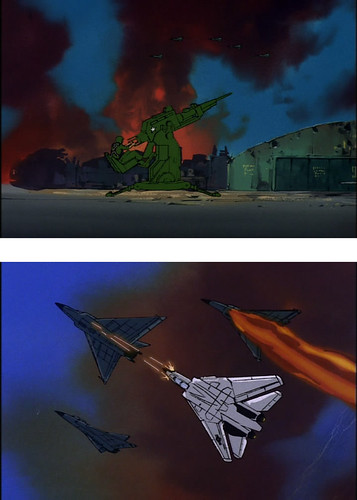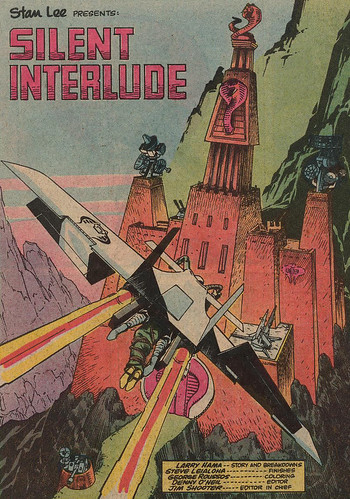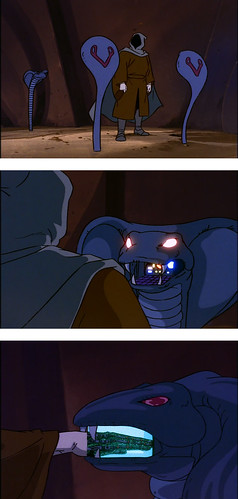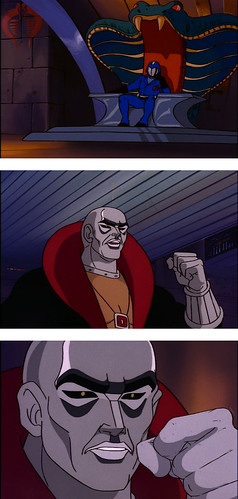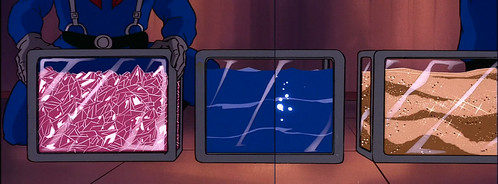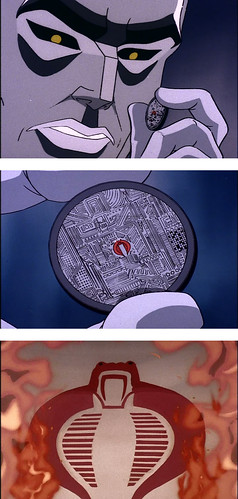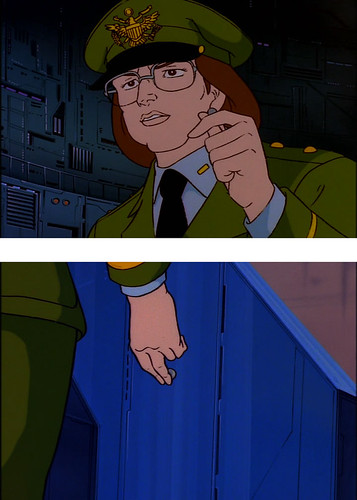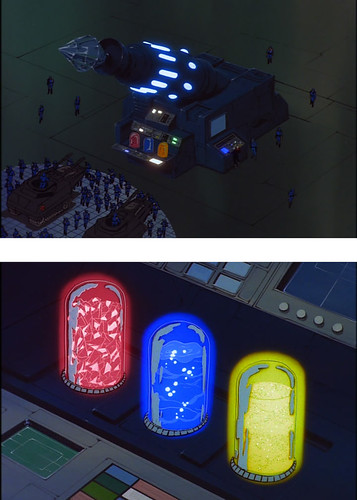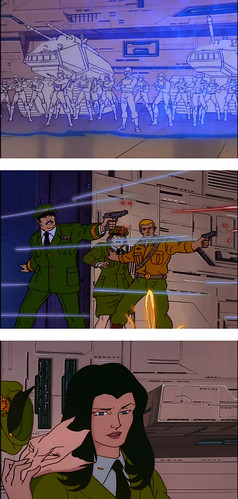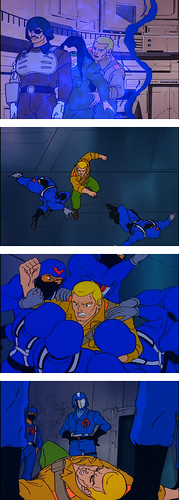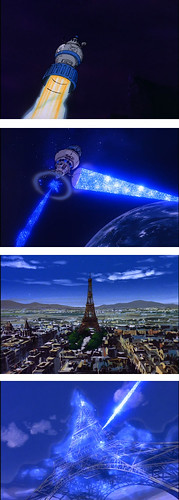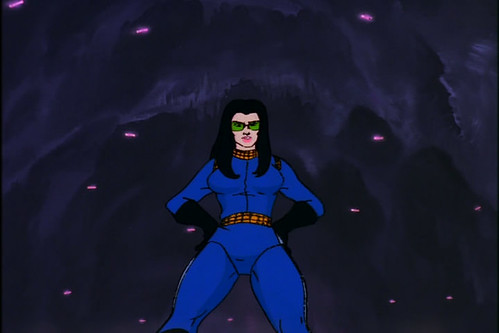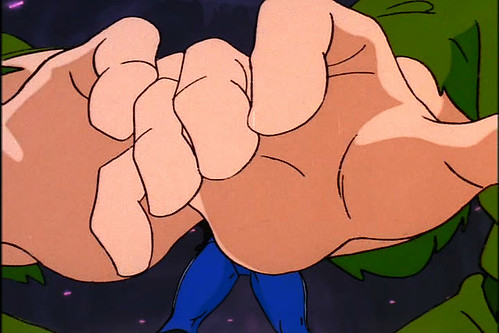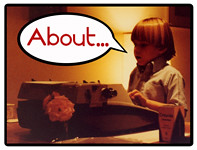I recently had a fire lit under my butt to get back into podcasting and the result was re-launching the Saturday Supercast as a co-host alongside Jerzy Drozd and Kevin Cross. The Supercast was originally intended as, and still is, a behind the scenes look into the Sugary Serials all ages comic anthology, which as readers of Branded have no doubt heard me speak of in the past, is inspired by the Saturday morning and weekday syndicated cartoons the creators grew up with throughout the 70s and 80s. So it seemed fitting to relaunch the show taking a deconstructionist’s view of cartoons to the Supercast. Jerzy and I were inspired by Anthony and Ted of the Horror Etc. podcast, and the format they’ve chosen to take a focused look at the genre, sometimes with a fine tooth comb, examining a single film, and sometimes on a broader scale, taking in an entire subgenre. We also all feel that this is an examination that’s largely missing from cartoon themed podcasting and we hope we can take a shot at starting the conversation. You can find the first part of episode 19 of the podcast over at Sugary Serials right now or you can download it by right clicking and selecting save as here.
As we tackle each subject, I figured it would be a great opportunity to pour any excess research and any of my personal observations that don’t make it to the show into a revitalized Cartoon Commentary column. Anyway, we recently recorded a couple episodes, a two part series looking at the original five-part G.I. Joe mini series, A Real American Hero, so I thought I’d take a minute and breakdown some of my thoughts on the very frist episode of G.I. Joe. The show was produced in 1983 by Sunbow Productions in tandem with Marvel cartoon Productions and Hasbro. Sunbow had previously worked with Marvel on the Incredible Hulk cartoon, as well as animating the commercials for the Marvel G.I. Joe comic book series. This first mini series debuted on September 12th and ran the entire week. It wasn’t followed up until the next year when the second mini series, The Revenge of Cobra, debuted. The first episode in this mini is titled "The Cobra Strikes"…
One of the initial things that jumps out at my about G.I. Joe is just how much action there is in the show. The more and more I look back at the output of the 80s the more and more I fall in love with the freedom that cartoon studios found in the wake of industry regulations being loosened as Ronald Regan took office. Though this G.I. Joe mini series debuted only a week after He-Man and the Masters of the Universe, I think it directly benefited from the behind the scenes machinations of Filmation and Mattel circumventing typical Saturday morning scrutiny by the network watchdogs (by selling the show to first run syndication) as well as the FCC looking away from television programming developed off of existing toy lines. Some might look at this as a bad thing, but in the wake of an entire decade of cartoon programming strictly devoid of most action and adventure elements, it seems like a breath of fresh air to me.
The opening images of the credit sequence explode into frame literally as the battle between G.I. Joe (the codename for America’s daring, highly-trained special mission force) and Cobra (a ruthless terrorist organization determined to rule the world) is introduced to the audience very succinctly in under in a minute.
As the episode opens it manages to keep up the action as a squadron of Sky Strikers is being tested out. We’re introduced to the core of the Joe cast as a jet flown by one of their own does an all to close fly by forcing Duke to go on the rampage, only to be taken aback as it’s revealed that the Sky Striker in question was being piloted by Scarlett, the team’s resident girl of action. What’s so great about this scene is that so much information about the tone and look of the show, as well as character archetypes are cemented in a very short amount of time. Not only do we get some pretty great and very dynamic "camera" work in the animation but the in the four or five lines of dialogue we get Duke’s personality and his relationship to Scarlett in a nutshell. There are two scenes of really great animation angles in this sequence; one where the p.o.v. of the camera is hovering off the ground, about 25 feet up pointed down a landing strip and a Sky Striker goes zooming overhead into the frame and then lands. The second shot is a worm’s eye view, flipped 180 degrees down the runway as the jet comes to a stop right before it would "crush" the camera. After years of Filmation and Hanna Barbera controlling the cartoon landscape with a lot of side scrolling and limited animation cartoons, again, this is just an exciting breath of fresh air.
There are also a lot of great textures in the background paintings that really add depth to the images while allowing the flat colorful cels really pop. As far as storytelling goes, I think visually it was kind of interesting that the designers chose to use the IAI Kfir Israeli fighters as the model for the Cobra aircraft that attacks the Joe base in the first few minutes even though the writer’s guide sort of frowns on the use of other nations as villains. Sure, most kids aren’t going to pick-up on that sort of imagery and think that Cobra is getting their arms from Israel, but it’s still sort of strange. It’s another shining example of the cold war xenophobia that was so prevalent in 80s action entertainment like Top Gun and Iron Eagle. If it wasn’t the Israelis and their Kfirs, then it was the Russians and their Migs…
Actually, for the most part the writers did a pretty good job of keeping Cobra separate from being visually allied with any of the obvious U.S. aggressors. In fact looking at the screen shot of the Cobra compound above, it would be easier to believe that Cobra was aligned with Vlad Tepes or Vicktor Von Frankenstein (which Kevin Cross astutely points out in the Saturday Supercast.) I love this crazy 1930s Universal horror version of a Cobra base (right down to the superstitious peasants helping to lug the M.A.S.S. device elements for a very druid-ish clad Destro) even for its amazing over branding of the snake theme. I think even some of the cobras has Cobra symbols on them. It’s also interesting to note that this same creepy castle design for the headquarters was echoed in some of the early Marvel comics issues, again pointing to the fact that the cartoon designers were taking nods from the comic and not necessarily Hasbro.
The scene where Destro approaches the temple is a great example of one of the most stressed tenants in the G.I. Joe writer’s guide, which was encouraging the inclusion of an element of the fantastic in each script. The fantastical elements could range the gamut of improbable technology, to monsters and mysticism, and the almost living giant cobras surrounding the temple mix all of these into one great visual. Not only can these robotic cobras scare the bejesus out of passers by, but they are also functional as laser defense and as scanning devices. I think it’s really interesting that when Destro enters his hand for the recognition software to process, it displays in an almost X-ray style exposing an apparent cybernetic nature to his hands. This is another example of how weird a character Destro really is. Besides his insane metal mask, unlikely voice (he sounds very African, yet later we discover he’s really of Scottish decent), and his glowing green eyes there’s the hint that he may be part machine.
I really do love the intense set design of these early episodes of G.I. Joe. I know later the crazy temples are replaced by a similarly cool Terrordrome, though it’s much more toned down in its modern design, and not nearly as creepy. But I love Cobra Commander’s throne, it’s just so over the top in its evil design. Speaking of evil design, I thought it was kind of odd that the shading on Destro’s face seems to subtly point to a visual reference to Hitler’s mustache. His upper lip divot is always overly shadowed in this first mini series, a visual cue that’s abandoned in the second mini series and in the subsequent syndicated episodes.
One of the conceits of this first mini series that really works for me is the three catalytic elements needed to power the M.A.S.S. devices. It sets up the five episode arc in a very fun way with an introductory episode, then three episodes which all deal with one of the elements, and finally a conclusion episode. Ron Friedman, the writer of this mini series (as well as the rest of the G.I. Joe mini series episodes, the movie and Transformers the movie) does a great job of spreading these elements all over the globe which creates the opportunity to showcase the Joes in all sorts of different environments.
We had a fun discussion on the Saturday Supercast about the branding of Cobra. Particularly in this mini series, anything that can be branded is, even the tiniest microchip sports the Cobra insignia. This is far from a complaint though, and it’s something that I think is missing from other 80s action shows that featured differing factions. I mean where were the iconic symbols in He-Man or the Go-Bots? I wonder if this was something that Hasbro contributed, or if staffers from Marvel were in talks with the toy company at the design stage? It’s certainly something that is strong in comics, and Marvel was involved to an extent in the development of both Transformers and G.I. Joe…
One of the things that I was looking for while re-watching this mini series is interesting aspects to the animation. I always remembered G.I. Joe for having some of the better visuals, what with taking on a more anime feel to the art as well as having great acting. I think this mini might slightly stand apart in the acting realm, at least on how far the expressions on some of the main characters go. The shot above of Duke is great, comically perplexed and goofy. I was listening to an episode of Ted Seko’s Idiot Engine podcast recently and one of his guests A. L. Baroza made an excellent point about the hamminess of acting in cartoons. Basically American animation studios strive for a 1930s acting style from their characters as it’s this ham-fisted overacting that really comes across well in animation, whereas the quieter brooding performances that we tend to laud in live action films doesn’t translate all that well and comes across boring and static in cartoons…
Alongside the great acting, and going back a bit to where I was talking about the rich textures in the background work, another very strong aspect to the BG work in G.I. Joe was all the modern mechanical paneling in the show. I’m flabbergasted by the level of detail in the electronic and metal paneling in the various settings of the show. It’s an aspect to the overall design of the cartoon where noting is boring to look at. I’d love to have some of these paintings, sans characters, framed and on my walls, that’s for sure…
Something that I thought was kind of interesting in the first half of the episode was the dichotomy between the over the top action and some of the subtlety in the character action. In particular the scene that strikes me the most involves the Baroness in disguise during the tour of the satellite compound. The character keeps fingering her earring throughout the tour, but it really doesn’t draw all that much attention to itself, at least not until she takes off the earring and it’s revealed to be a Cobra tracking device. It’s one of the cues in the writing translated into the animation that shows the forethought of the pacing and reveal. A similar thing happens in a later episode of the mini series with Duke’s Joe class ring, which sparkles a couple times before he eventually gives it to another character. Not everything in the show is this subtle, in fact it’s more likely to see some over the top bits, or convenient Deux Ex Machinas, but it’s nice to find both in a series like this from the 80s.
In fact, just after the subtlety of the earring, we get the craziness of Duke’s pre-guessing the reason he was invited on the tour, which was to have his Joe team initiate a break-in on the compound to test its security. Of course seeing this coming Duke has already mobilized this mission which conveniently kicks off seconds after the request is given to him.
Getting back to the fantastical elements of the series for a second, the major one for this mini series is the introduction of the M.A.S.S. device, which has the ability to teleport matter via an energy beam. This sets the tone for the various crackpot schemes that Cobra will attempt over the series. I like the mixture of mad science and mysticism of the design in that it needs these crazy catalytic elements to work.
In the scene where Cobra stages a surprise attack on the satellite installation, it’s kind of interesting to note that there are a couple of weird visuals and sound cues. First off, the general and Duke are carrying handguns, which is something you don’t typically see in the show, at least not realistic looking ones. I think a handful of the toys came with them, but usually they were just molded onto the figure and couldn’t be removed. As for the sound cues, up until the last episode of this mini series, whenever the Joes are firing their weapons they typically make realistic gunfire noises (mostly machine gun fire.) This is something that was probably a complete no-no as far as the networks standards & practices, not to mention the lobbyists from Action for Children’s Television were concerned. The question I have though is whether or not these were the same sound effects which aired back in ’83 and eventually in the show’s syndication run. The version of the mini series that I own was released by Rhino in and around 2000, and I’ve read a number of times that they either replaced some of the sound effects or used ones from the original masters and not the eventual fixed broadcast tapes. Either way, it’s something that would disappear very quickly from the show as both Cobra and the Joes fire lasers almost exclusively.
One of the aspects to this mini series that Jerzy, Kevin and I had a lot of fun talking about on the Saturday Supercast podcast is the character of Duke. Jerzy asserted that Duke is basically the 80s equivalent of William Shatner’s depiction of James Kirk on the original Star Trek. They’re both one part man of action, one part lady’s man, and both wouldn’t hesitate to roll right from knocking down a fellow officer a peg or two to hitting on a woman in peril. Another example of his tenacity, and really all the Joes express this trait, is how much he fights when captured by Cobra. He get’s sucked into the cloud of energy from Cobra’s M.A.S.S. device as it teleports their troops and the satellite back to their temple, and even though he has no idea what’s going on or where he is, he hits the ground running, punching and kicking everything with a Cobra symbol. It literally takes like 10 officers to drag him down and knock him out…
In fact, after Cobra makes their demands on the world and they take a moment to have some fun with Duke in their battle arena, Duke is at it again. He’s left alone for a couple of seconds before he jumps up onto a huge banner lining the wall under Cobra Commander and Destro, and starts climbing it to get to them. This guy just never stops fighting Cobra.
I’m jumping ahead a bit, but in this arena sequence, there’s an awesome nod to the Atari 2600 in that Destro and Cobra Commander can control the contestants via headband and a joystick controller that looks a whole heck of a lot like the 2600 controller. It makes for a very fun and slightly dated reference to the home systems of the time, and is for all intents and purposes the laying the groundwork for the very first fighting game, pre-Mortal Kombat and Street Fighter.
Anyway, back to the chronology while at the same time tributary-ing to talk a bit about the trailer for the upcoming G.I. Joe live action film. On the whole, I really don’t care for most of the footage I’ve seen so far of the new flick. It doesn’t help that I’m not a fan of the director (having been mildly amused by the first Mummy movie, and downright hating Van Helsing), but it also doesn’t help that I’m a fan of the look and feel of the 80s cartoon. Before I sound like a mighty curmudgeon I have to admit that I’m also not a fan of the 60-70s G.I. Joe either, and I realize that the new film really isn’t being made for guys and gals like me, it’s being made for a new audience. What I did like though was the centerpiece, the Cobra (well, I think it’s still just M.A.R.S., Destro’s outfit at that point) attack on the Eiffel Tower. I’m pretty sure Larry Hama was used as a consultant on the flick during the script revision process, and I’d be willing to be this may have been one of his suggestions. See in the first episode of G.I. Joe the first major target that Cobra goes after with the M.A.S.S. device is the Eiffel Tower, teleporting it to god knows where. Granted, in the aftermath of Independence Day and the million similar summer blockbusters that followed, it’s sort of trite to see a well known international landmark destroyed with crazy CGI, but at the same time it really warmed my heart.
Also, I think the costume designers did a pretty good job of nailing the look of the Baroness in the new flick, though honestly, how could you go wrong? Well, I sort of have tunnel vision when it comes to the Baroness as I only really remember her in the skintight black leather (pleather?) outfit from the later episodes of the cartoon and from her first toy. Part of this is due to the fact that I never had a Baroness figure growing up. I actually didn’t have any of the female characters except Jinx, and probably only because my mom didn’t realize she was a girl in her red ninja pajamas. Looking back, I only had one female action figure, Evil-Lyn from the He-Man line, and I ended up scraping the paint off her breast plate to try and get a look underneath, and I’m sure that made my parents worry. My friend had the Baroness figure though, and I coveted it as I did with most of his figures and vehicles because it seemed like he had all the stuff I never had.
Well, when the 25th anniversary figures started coming out you can figure that the Baroness was right there at the top of my list of figures to procure. I bought the Cobra 5-pack just to get her and hoped beyond hope that Hasbro would release a single carded version so I could have the card art as well. Unfortunately, of all the original 10 figures in that line, the Baroness was the one fire that didn’t get the single card treatment, at least not the black leather version. Instead the version released had her in a blue and yellow getup with green sunglasses, the polar opposite of what I remembered, and I just chalked it up to a silly repaint. Lo and behold though, when I re-watched this first mini series, that this was the original Baroness costume as you can see above. After doing some research I noticed this costume matched the early appearances in the comics, which at this point maybe Sunbow only got a vague description of the character. These properties were being developed in tandem but without a lot of communication over the various mediums, toys, cartoon, and comics, so maybe the cartoon was taking a nod form the comics. I know her first figure didn’t come out until 1984, and if I remember correctly, she was in her trademarked black suit in the second mini series. Anyway, after holding a grudge against the blue and yellow version in the 25th line for the last year, it was a shock to see her in that getup in the first episode.
One of the other interesting things I noticed about this episode was the penchant for closing out the cliffhangers (both while cutting to commercial and the end of the episode) with evil characters grabbing toward the hero who is serving as the point of view. You get these giant hands clutching in towards the camera. It’s pretty darn effective.
I also came to the conclusion that the villains wear a lot of masks. What with Destro and Cobra Commander in general, and later Storm Shadow and Zartan, but we even get the Baroness and Major Bludd sporting Mission Impossible style masks. It’s almost a theme that the masked characters are bad, but then there’s the glaring exception to the rule in Snake Eyes. Not only does he wear a mask (that we never get to see under), but he’s also completely clad in black (well, except for his gloveless hands in this mini series), and his name is "Snake" Eyes. I mean in a show where every single reference to a snake points toward Cobra, it’s kind of weird that the character was designed as he was. Maybe Hasbro realized the potential in the popularity of villains at that point and decided to bring a little of that to the heroes’ side?
Last but certainly not least for this episode is the introduction of Remar, the gargantuan 15 foot tall ogre of a man that Cobra uses as a gladiator and slave. Again, this is yet another example of the writer’s credo that nothing is off the table in the series. I think this is one of the strongest aspects of the show and why it has the longevity and replay-ability that it does. Straight combat between Joe team members and Cobra would get pretty boring after awhile and the addition of these sorts of fantastical characters and situations really make the show fun and adventurous. I guess it’s sort of functioning on the same level that makes the Indiana Jones franchise work so well.
Next time on Cartoon Commentary! episode 2 of the A Real American Hero mini series, "Slave of the Cobra Master". Again, you can listen to Jerzy Drozd, Kevin Cross and I talk about this series on the Saturday Supercast podcast. Also, this mini series will finally be released on DVD again this Tuesday on the awesome season 1.1 DVD from Shout! Factory.


